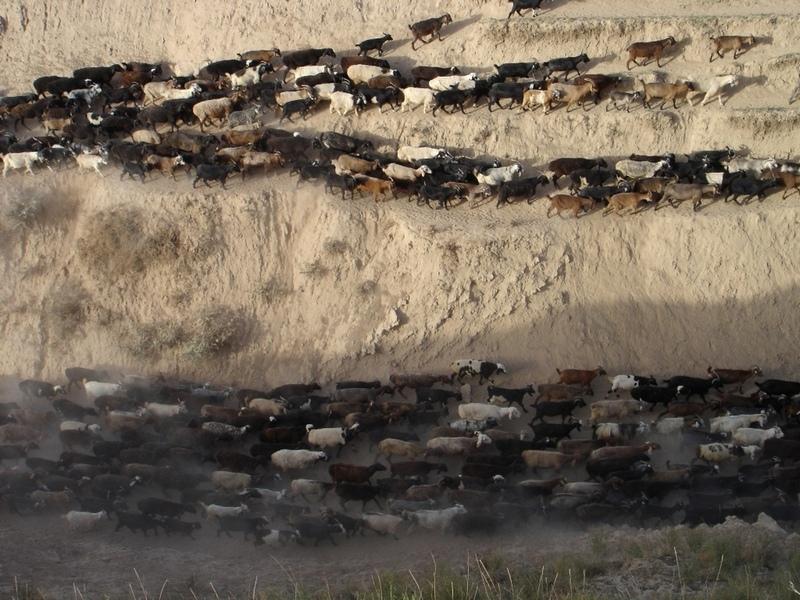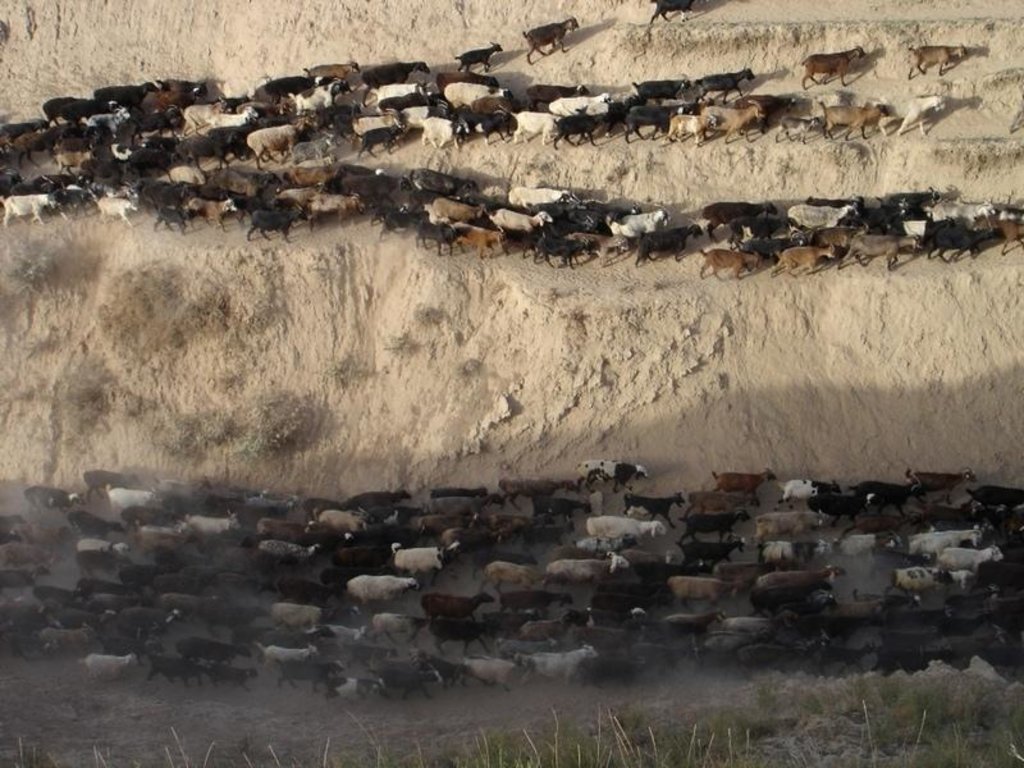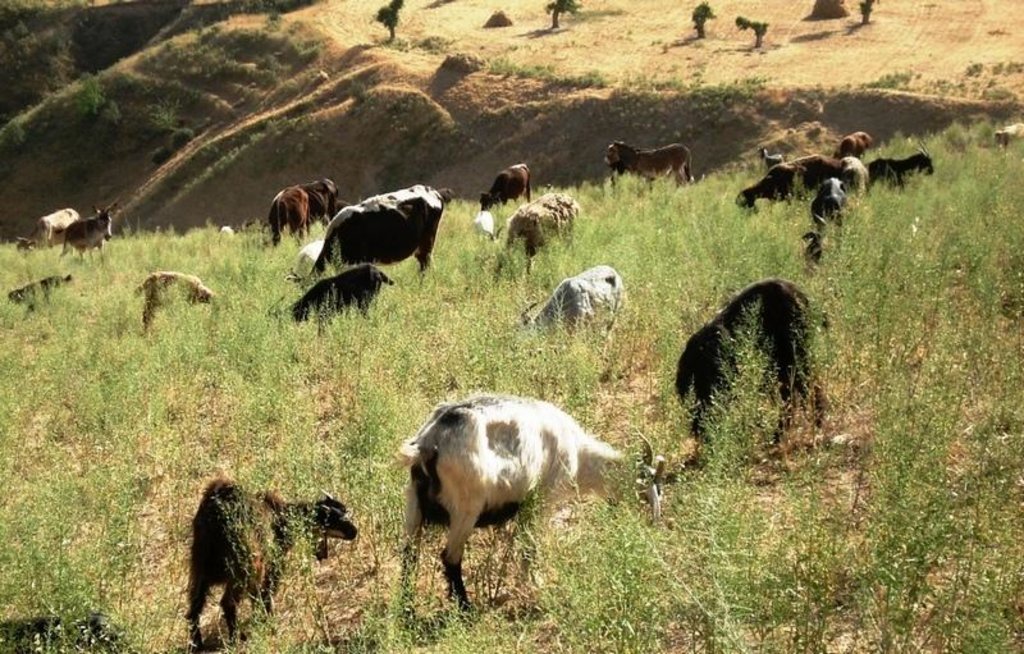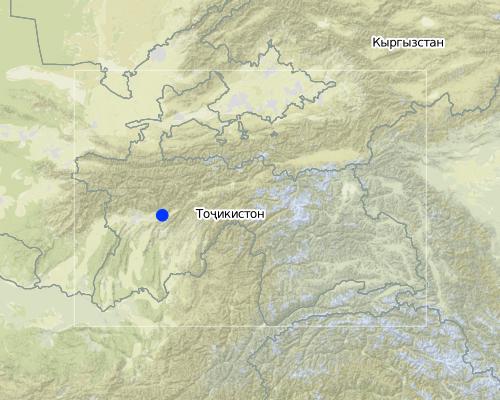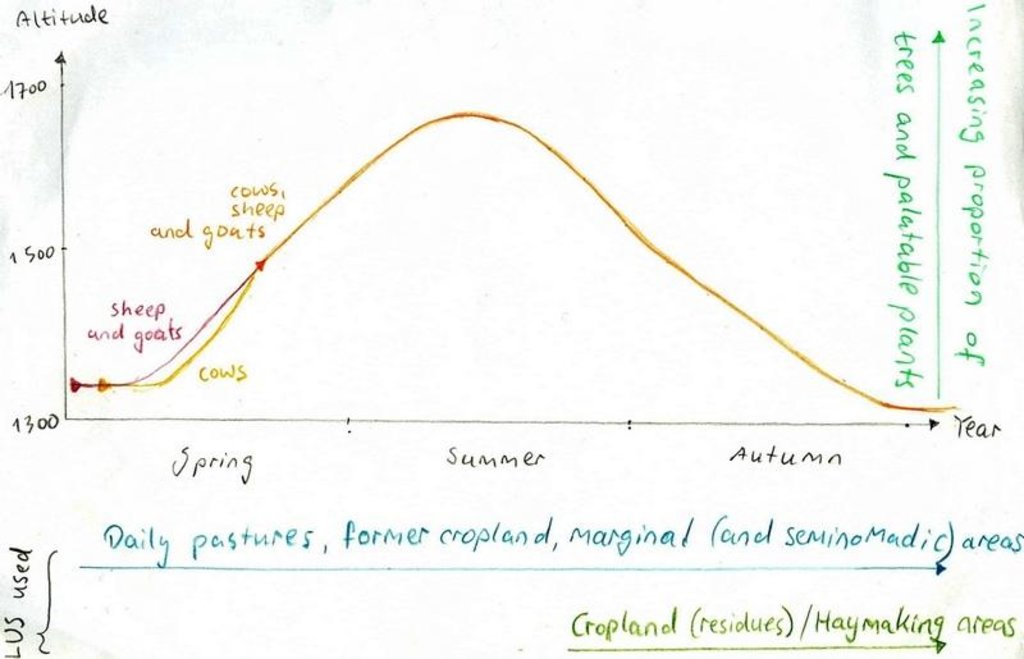Daily grazing of village-herds [Tajikistan]
- Creation:
- Update:
- Compiler: Christian Wirz
- Editor: –
- Reviewer: David Streiff
Charogo bistumi (pasture for everyone)
technologies_1408 - Tajikistan
View sections
Expand all Collapse all1. General information
1.2 Contact details of resource persons and institutions involved in the assessment and documentation of the Technology
Name of the institution(s) which facilitated the documentation/ evaluation of the Technology (if relevant)
CDE Centre for Development and Environment (CDE Centre for Development and Environment) - SwitzerlandName of the institution(s) which facilitated the documentation/ evaluation of the Technology (if relevant)
NCCR North-South (NCCR North-South) - Kyrgyzstan1.3 Conditions regarding the use of data documented through WOCAT
When were the data compiled (in the field)?
01/08/2008
The compiler and key resource person(s) accept the conditions regarding the use of data documented through WOCAT:
Yes
1.5 Reference to Questionnaire(s) on SLM Approaches
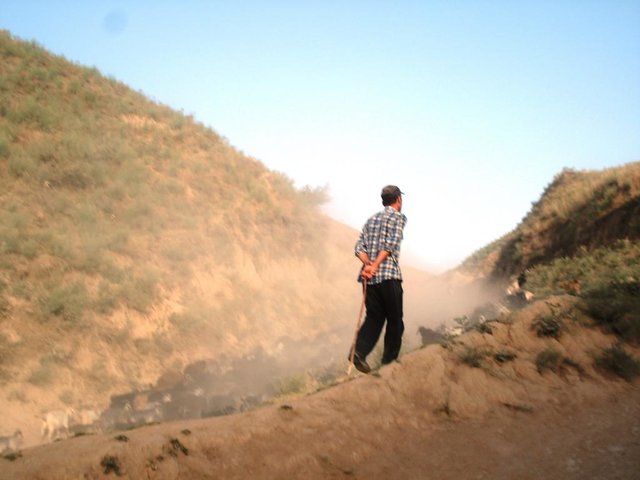
Common village herding [Tajikistan]
Village herding system with daily alternation of the herders including each household in a monthly turnus.
- Compiler: Christian Wirz
2. Description of the SLM Technology
2.1 Short description of the Technology
Definition of the Technology:
Rotational grazing on village pastures with heavy pressure with daily to weekly change of grazing places.
2.2 Detailed description of the Technology
Description:
The herding season is from the beginnning of March to the End of Octobre or even beginning of Decembre. Total area is between 10-20 km2, depending on how strictly the borders are understood. Cows, sheep, goats and donkeys compose the herds. Grazing begins when soil moisture begins to decreaset, first with the little animals, that are supposed to better cope with slippery conditions. After two weeks the cows are led to the pastures and in some cases they will be grazed alone, because sheep and goats disturb them. The grazing zone is situated between 1400 and 1700 m. Rotation begins on the lower pastures, at the beginning of summer the higher pastures are used and towards autumn the animals graze near the villages again, sometimes on cropland, feeding on crop residues. The herders are advised to change place after 2-3 days, but often stay in one place for a longer time. The animals are gathered on the way out of the village a little after dawn, than brought to the pastures. At noon-time they will be lead to a shady place close to a stream, if possible. The same places are visited three or more times per season.
Purpose of the Technology: The animals should be nourished and the cows should give milk. A land user kept his cow at home towards the end of summer, because it stopped giving milk, from the sparse and dry vegetation on the pastures.
Establishment / maintenance activities and inputs: The costs for this form of herding are lost days at school for the children. It largely works without external inputs (such as fertilisers). Other inputs such as salt for the animals are covered by the landowner.
Natural / human environment: These pasture-areas are heaviliy suffering from overuse on one hand and from droughts on the other side. They are in a generally well-conserved state. Fractional vegetation cover is low, especially tree cover, and the proportion non-palatable species relatively high. Erosion by water, including gullies, and crusting, are common phenomena, especially in low cover areas.
2.3 Photos of the Technology
2.5 Country/ region/ locations where the Technology has been applied and which are covered by this assessment
Country:
Tajikistan
Region/ State/ Province:
Region of Republican Subordination
Further specification of location:
Faizabad
Map
×2.6 Date of implementation
If precise year is not known, indicate approximate date:
- more than 50 years ago (traditional)
2.7 Introduction of the Technology
Specify how the Technology was introduced:
- as part of a traditional system (> 50 years)
Comments (type of project, etc.):
Already before the USSR the villages used to have their hamlets and grazed them around the villages, but also in the formerly not very populated plains. By the settlement of people in the plains and population growth from the 1970ies onward livestock numbers and pressure on natural resources started to increase there. And through Soviet collective agriculture people were forced to keep livestock close to the villages, as a consequence of their employment. In addition, grazing on the territory of forest administration, founded in the 1960ies, was forbidden for the villagers.
3. Classification of the SLM Technology
3.2 Current land use type(s) where the Technology is applied

Grazing land
Extensive grazing land:
- Ranching
Main animal species and products:
sheep and goats / cows and donkeys.
Comments:
Major land use problems (compiler’s opinion): Soils are heavily degraded in the sense of generally high levels of compaction and crusting and low organic matter contents. Vegetation is especially reduced in cover, not necessarily in biomass and, the fraction of good pasture species is low.
Major land use problems (land users’ perception): Many trees have been cut down during civil war and till today, leaving back a soil without protection. Animals grazing on these pastures are not fat, often sick and cows give little and sometimes (in summer) no milk. An often mentioned problem is the situation of drought in 2008 and animals staying in one place for longer periods, which leads to degradation of vegetation.
Ranching: sheep and goats / cows and donkeys.
Grazingland comments: In spring sheep and goats are herded before cows, then in a separate herd and toward the end of the season, together.
Type of grazing system comments: In spring sheep and goats are herded before cows, then in a separate herd and toward the end of the season, together.
3.3 Further information about land use
Water supply for the land on which the Technology is applied:
- rainfed
Number of growing seasons per year:
- 1
Specify:
Longest growing period in days: 270Longest growing period from month to month: Oct - Jul
Livestock density (if relevant):
< 1 LU/km2
3.4 SLM group to which the Technology belongs
- pastoralism and grazing land management
3.5 Spread of the Technology
Specify the spread of the Technology:
- evenly spread over an area
If the Technology is evenly spread over an area, indicate approximate area covered:
- 10-100 km2
Comments:
Total area covered by the SLM Technology is 15 m2.
For some villages figures are available, for instance for Karsang: This village has alltogether 850 ha of common grazing land, for officially 212 cows and 775 little animals. For the whole Jamoat the figures are of around 2500 ha of pasture-land (not all in the study-area) for 2695 cows and 5950 little animals.
3.6 SLM measures comprising the Technology

management measures
- M1: Change of land use type
Comments:
Main measures: management measures
3.7 Main types of land degradation addressed by the Technology

soil erosion by water
- Wt: loss of topsoil/ surface erosion
- Wg: gully erosion/ gullying
- Wm: mass movements/ landslides

biological degradation
- Bc: reduction of vegetation cover
Comments:
Secondary types of degradation addressed: Wt: loss of topsoil / surface erosion, Wg: gully erosion / gullying, Wm: mass movements / landslides, Bc: reduction of vegetation cover
Main causes of degradation: overgrazing (Big livestock numbers on little surface.), poverty / wealth (People depend on livestock and on cheap pastures.)
Secondary causes of degradation: droughts (Many people mention that rainfalls were much lower in 2007-2008 than normally.), population pressure (Especially from the 1970ies onward population increased rapidly.), land tenure (As long as no-one is really responsible for the are, conservation measures are difficult to implement.), war and conflicts (Civil war was detrimental to the (little) economic, non-agricultural sector (textiles, car-parts) and to the institutions, so that many people had to return to agricultural activities.)
3.8 Prevention, reduction, or restoration of land degradation
Specify the goal of the Technology with regard to land degradation:
- reduce land degradation
Comments:
Main goals: mitigation / reduction of land degradation
4. Technical specifications, implementation activities, inputs, and costs
4.1 Technical drawing of the Technology
4.2 Technical specifications/ explanations of technical drawing
Rotation of the village herds.
Location: Karsang and other villages. Faizabad
Date: 20.08.09
Technical knowledge required for land users: low (The practiced rotation follows the humour of the herders (often children) and is not complicated.)
Secondary technical functions: improvement of surface structure (crusting, sealing), increase of biomass (quantity)
Change of land use practices / intensity level: The begin of grazing and the rotation is fixed by a village committee. Animals should not stay at one place for longer than 3 days.
4.3 General information regarding the calculation of inputs and costs
other/ national currency (specify):
Somoni
Indicate exchange rate from USD to local currency (if relevant): 1 USD =:
3.42
4.4 Establishment activities
| Activity | Type of measure | Timing | |
|---|---|---|---|
| 1. | Villagers buy animals, usually 6-10 goats and / or sheep, 1-2 cows and / or donkeys. | Management | Constantly size is regulated. |
4.5 Costs and inputs needed for establishment
| Specify input | Unit | Quantity | Costs per Unit | Total costs per input | % of costs borne by land users | |
|---|---|---|---|---|---|---|
| Other | buy the animals | per year | 1.0 | 1170.0 | 1170.0 | 100.0 |
| Total costs for establishment of the Technology | 1170.0 | |||||
4.6 Maintenance/ recurrent activities
| Activity | Type of measure | Timing/ frequency | |
|---|---|---|---|
| 1. | Per capita fee taxes | Management | Once per year. |
| 2. | Buying concentrated feed, depending on the financial resources of the land user. | Management | Bought once per year, for winter period. |
| 3. | Haymaking and / or buying, depending on labour, financial resources and livestock numbers. | Management | June-July, respectively later, if bought. |
| 4. | Medecine and salt for animals | Management | Irregularly, resp. daily to weekly. |
4.7 Costs and inputs needed for maintenance/ recurrent activities (per year)
| Specify input | Unit | Quantity | Costs per Unit | Total costs per input | % of costs borne by land users | |
|---|---|---|---|---|---|---|
| Other | Per capita fee taxes | per year | 12.0 | 1.0 | 12.0 | |
| Other | Buying concentrated feed | kg | 425.0 | 0.53 | 225.25 | |
| Other | Medecine and salt for the animals | for all animals | 1.0 | 45.0 | 45.0 | |
| Total costs for maintenance of the Technology | 282.25 | |||||
Comments:
The calculated costs apply to each land user's cost for this herding system.
4.8 Most important factors affecting the costs
Describe the most determinate factors affecting the costs:
The most important cost factor is buying livestock. Recurrent costs are low, but rent fees for pastures are percieved as being high.
5. Natural and human environment
5.1 Climate
Annual rainfall
- < 250 mm
- 251-500 mm
- 501-750 mm
- 751-1,000 mm
- 1,001-1,500 mm
- 1,501-2,000 mm
- 2,001-3,000 mm
- 3,001-4,000 mm
- > 4,000 mm
Agro-climatic zone
- semi-arid
Thermal climate class: subtropics
5.2 Topography
Slopes on average:
- flat (0-2%)
- gentle (3-5%)
- moderate (6-10%)
- rolling (11-15%)
- hilly (16-30%)
- steep (31-60%)
- very steep (>60%)
Landforms:
- plateau/plains
- ridges
- mountain slopes
- hill slopes
- footslopes
- valley floors
Altitudinal zone:
- 0-100 m a.s.l.
- 101-500 m a.s.l.
- 501-1,000 m a.s.l.
- 1,001-1,500 m a.s.l.
- 1,501-2,000 m a.s.l.
- 2,001-2,500 m a.s.l.
- 2,501-3,000 m a.s.l.
- 3,001-4,000 m a.s.l.
- > 4,000 m a.s.l.
Comments and further specifications on topography:
Altidudinal zone: Most pastures are close to the villages, on around 1300-1500 m, but some pastures reach altitudes of 1600-1700 m.
Landforms: The pasture-areas usually follow N-S-ridges and most pastures are in slope-areas.
Slopes on average: Also hilly
5.3 Soils
Soil depth on average:
- very shallow (0-20 cm)
- shallow (21-50 cm)
- moderately deep (51-80 cm)
- deep (81-120 cm)
- very deep (> 120 cm)
Soil texture (topsoil):
- medium (loamy, silty)
Topsoil organic matter:
- low (<1%)
If available, attach full soil description or specify the available information, e.g. soil type, soil PH/ acidity, Cation Exchange Capacity, nitrogen, salinity etc.
Soil texture (topsoil): Loess soils
Soil fertility low: In most places high proportions of non-graminoids and leguminous species.
Topsoil organic matter: High proportion of hot-spots and degrading areas according to Wolfgramm's (2007) hot-brightspot-map.
Soil drainage / infiltration poor: Most soils are crusted and compacted.
5.4 Water availability and quality
Ground water table:
> 50 m
Availability of surface water:
poor/ none
Water quality (untreated):
poor drinking water (treatment required)
Comments and further specifications on water quality and quantity:
Ground water table: Often no groundwater, because too hilly
Availability of surface water: Most areas far from open water bodies
Water quality (untreated): No pesticides, but water is contaminated by animal dung.
5.5 Biodiversity
Species diversity:
- low
Comments and further specifications on biodiversity:
In comparison with other areas.
5.6 Characteristics of land users applying the Technology
Market orientation of production system:
- subsistence (self-supply)
- commercial/ market
Off-farm income:
- > 50% of all income
Relative level of wealth:
- average
Individuals or groups:
- individual/ household
Gender:
- women
- men
Indicate other relevant characteristics of the land users:
Land users applying the Technology are mainly common / average land users
Difference in the involvement of women and men: Many children are working as herders, because of labour shortage (young men in Russia).
Population density: < 10 persons/km2
Annual population growth: 1% - 2%
30% of the land users are rich (People who have a house made of concrete or with a ribbed roof instead of one made of cement asbesto).
70% of the land users are average wealthy (Compared to the rest of society: People have enough food, children go to school, they have a mud-hou).
Off-farm income specification: Nearly all people have family members (mostly sons) in Russia, who send remittances.
Market orientation of production system subsistence (self-supply): Animals are mainly used for own consumption (meat and milk).
Market orientation of production system commercial / market: Animals are sold, if the family needs money (for medecine or education).
So, it is still better from their perspective to have animals ("as a bank", according to many villagers), than not having this security. And it is comparatively cheap, even if a land user admits that he has to feed his cow with leaves of his muleberry trees, because pastures are so unproductive, that his cow does not give milk anymore (in August).
5.7 Average area of land owned or leased by land users applying the Technology
- < 0.5 ha
- 0.5-1 ha
- 1-2 ha
- 2-5 ha
- 5-15 ha
- 15-50 ha
- 50-100 ha
- 100-500 ha
- 500-1,000 ha
- 1,000-10,000 ha
- > 10,000 ha
Is this considered small-, medium- or large-scale (referring to local context)?
- small-scale
Comments:
Average area of land owned or leased by land users applying the Technology 2-5 ha: This corresponds to the average for the whole study-area, including haymaking areas.
Average area of land owned or leased by land users applying the Technology 5-15 ha: Households having a farmer's association mostly have more than the average.
Average area of land owned or leased by land users applying the Technology 15-50 ha: Some rich families even have more land that they rent to others.
5.8 Land ownership, land use rights, and water use rights
Land ownership:
- state
Land use rights:
- open access (unorganized)
- communal (organized)
Comments:
Pasture-use is theoretically regulated as described above, but additionally to the village herd there are other herders with private animals using the same pastures.
5.9 Access to services and infrastructure
health:
- poor
- moderate
- good
education:
- poor
- moderate
- good
technical assistance:
- poor
- moderate
- good
employment (e.g. off-farm):
- poor
- moderate
- good
markets:
- poor
- moderate
- good
energy:
- poor
- moderate
- good
roads and transport:
- poor
- moderate
- good
drinking water and sanitation:
- poor
- moderate
- good
financial services:
- poor
- moderate
- good
6. Impacts and concluding statements
6.1 On-site impacts the Technology has shown
Socio-economic impacts
Production
fodder quality
Comments/ specify:
Compared with all other areas the proportion of forbs is very high.
animal production
Comments/ specify:
Compared with an efficient grazing rotation, returns (in terms of milk and meat) are very low.
wood production
Comments/ specify:
Very little trees are left because of goats eating them.
product diversity
Comments/ specify:
During war most people depended on cropland (wheat).
Income and costs
workload
Comments/ specify:
This system does not depend on professional herders, is thus economic, also in financial terms.
Socio-cultural impacts
food security/ self-sufficiency
Comments/ specify:
It is better for land users to have communal pastures but worse than having a well-implemented rotational grazing system, but the family does not have to buy meat.
community institutions
Livelihoods and human well-being
Ecological impacts
Water cycle/ runoff
surface runoff
Comments/ specify:
Especially trampling paths of livestock are very vulnerable to water erosion
Soil
soil crusting/ sealing
Comments/ specify:
The degree of compaction is higher than elsewhere.
soil compaction
Comments/ specify:
The degree of compaction is higher than elsewhere.
soil organic matter/ below ground C
Comments/ specify:
Organic matter is very low compared with all other areas. Biomass might be stonger reduced with animals grazing earlier in spring.
Biodiversity: vegetation, animals
biomass/ above ground C
6.3 Exposure and sensitivity of the Technology to gradual climate change and climate-related extremes/ disasters (as perceived by land users)
Climate-related extremes (disasters)
Meteorological disasters
| How does the Technology cope with it? | |
|---|---|
| local rainstorm | not well |
Climatological disasters
| How does the Technology cope with it? | |
|---|---|
| drought | not well |
Comments:
Pasture areas, that remain the same since the USSR, could be changed every few years to permit their recovery and regrowth of trees, chopped during and after civil war. The very basic rotational schemes existing in all villages are little effective. It is not possible to recognise conservation effects due to the generally very critical state of resources.
6.4 Cost-benefit analysis
How do the benefits compare with the establishment costs (from land users’ perspective)?
Short-term returns:
positive
Long-term returns:
slightly positive
How do the benefits compare with the maintenance/ recurrent costs (from land users' perspective)?
Short-term returns:
positive
Long-term returns:
slightly positive
Comments:
The land users see the problem of reduced productivity when pastures are overexploited. They complain about having to sell animals, but mainly attribute this to droughts.
6.5 Adoption of the Technology
If available, quantify (no. of households and/ or area covered):
NA
Of all those who have adopted the Technology, how many have did so spontaneously, i.e. without receiving any material incentives/ payments?
- 90-100%
Comments:
Comments on acceptance with external material support: No subsidies have been paid for buying livestock. But, as people highly depend on remittances, it can be assumed that these have also been invested into livestock.
100% of land user families have adopted the Technology without any external material support
There is a moderate trend towards spontaneous adoption of the Technology
Comments on adoption trend: Young families who do not yet have livestock are thinking of buying animals in the future. On the other hand herding in the upper areas still has potential and wealthy people might want to send their animals there with professional herders in the future.
6.7 Strengths/ advantages/ opportunities of the Technology
| Strengths/ advantages/ opportunities in the land user’s view |
|---|
|
Animal husbandry is an economic basis which permits development. How can they be sustained / enhanced? People should be allowed to keep as much animals as they want to. And the pasture-area should not become smaller. |
| Strengths/ advantages/ opportunities in the compiler’s or other key resource person’s view |
|---|
|
It is the most cheap form of self-sufficient meat-production. How can they be sustained / enhanced? Pasture-quality needs to be preserved, otherwise the carrying-capacity of pastures will be reduced. |
|
Livestock with its semimonetary value is much more stable in value than money on the bank (increasing livestock prices). How can they be sustained / enhanced? Only if alternatives for animal husbandry emerge will the prices for livestock not fall. |
6.8 Weaknesses/ disadvantages/ risks of the Technology and ways of overcoming them
| Weaknesses/ disadvantages/ risks in the land user’s view | How can they be overcome? |
|---|---|
| Animals and pastures are less productive (reduced biomass) and pastures show more signs of erosion than those on forest department. There, pasture-areas are bigger and, by consequence, there is more space for herding. | If there were not always more people affording to rent land for orchards or haymaking the pressure on the remaining pastures would not increase. |
| The pastures very much depend on enough water: If there is little rain (like in 2008) animals return hungry from the pastures. | There is hope that the planned water pipe from Rogun (planned giant dam) will bring water for irrigation (of cropland, where animals graze in late summer and where forbs are collected as winter fodder). |
| Rent fees have to be paid, which are percieved as high by some land users. They fear additional per-capita animal taxes. | No more taxes should be introduced and herding should not be stronger regulated, because many people depend on animal husbandry. |
| This herding system is vulnerable to droughts and temperature increase, which are percieved as main degradation causes. Besides this, excessive livestock numbers are seen as a cause of cover reduction and compaction. Especially where animals graze the soil is naked and dry after 2-3 days. | It might be helpful to let the pastures recover for 3-5 years for trees (which bring moisture) to grow. But this might require administration through external institutions and people fear that they will not get back the pastures. |
| Weaknesses/ disadvantages/ risks in the compiler’s or other key resource person’s view | How can they be overcome? |
|---|---|
| Degradation of soils and vegetation on these relatively small areas is high and the pastures cannot recuperate due to constant pressure. | The pastures need to have periods of recovery. |
| The soils are decreasing in fertility because animal dung is used as energy source. | A not too expensive alternative for hot water might be solar heaters or charcoal. And to counteract general fertility problems interchanging pasture- and haymaking areas would bring dung everywhere. But this would require fencing of the remaining trees in order not to further damage vegetation cover. |
Links and modules
Expand all Collapse allLinks

Common village herding [Tajikistan]
Village herding system with daily alternation of the herders including each household in a monthly turnus.
- Compiler: Christian Wirz
Modules
No modules


